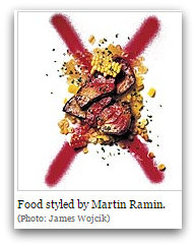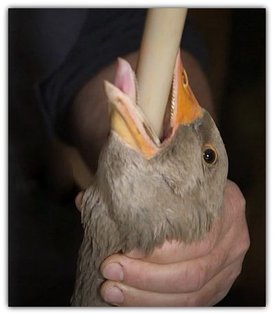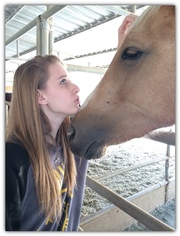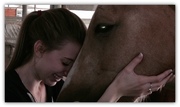
Foie Gras dates back to ancient Egyptians, who would take it with them on their trips down the Nile River. Ancient drawings have depicted farmers force feeding their geese. It became a delicacy, eaten by mostly emperors and noble men. During the middle Ages, it disappeared, but made a comeback in the 19th century. It was predominantly made in France, but became unavailable during the 1980s when the Americans banned the import of raw poultry. Because of this, American farmers began making their own Foie Gras. It was even served as the last dinner on the Titanic.

Aside from force-feedings, the birds are often neglected and abused with overcrowding, mutilations, and eventually slaughter. They have no access to swimming water which is essential to these birds to remain healthy. Studies show that France produces and consumes around 75% of the world’s foie gras. About 24 million ducks and half a million geese are killed every year for this appetizer. The European Union’s Scientific Committee on Animal Health and Animal Welfare have said, “Force feeding, as currently practiced, is detrimental to the welfare of the birds.” More than a dozen countries have prohibited foie gras production.
https://www.gourmetfoodstore.com/history-foie-gras-15165
http://www.wsj.com/articles/SB121207726422829649
http://animalrights.about.com/od/FactoryFarming/a/Foie-Gras.htm
http://www.stopforcefeeding.com/content/what-foie-gras
http://www.humanesociety.org/issues/force_fed_animals/
http://gourmetcruelty.com/about.php
http://www.spca.bc.ca/welfare/campaign-issues/the-truth-about-foie-gras.html
La Belle Farms has a red-coated USDA inspector watching their every move every day as the crew gets to work. They are able to process around 500 ducks a day, stunning them in electrified water so they’re unconscious when they’re killed and air-chilled to dry. The air-chilling and drying prevents them from gaining any water weight.
Weighing in at around a pound, each liver is roughly the size of a small football. That's close to 10% of the duck's total body weight, and it takes up the vast majority of the lower half of its body. The livers are sorted into two different grades, depending on the amount of bruises and blemishes they have. Any mishandling of the ducks—rough treatment will cause bruising, reducing its price. This gives a strong incentive to be gentle with the birds. Far from the cramped, cruel conditions shown in the videos and photographs, here is an enormous shed, full of birds free to roam as they pleased. La Belle uses and sells every part of the duck except the heads and feet.
The birds seemed to show a mild aversion to us, flocking together and giving us a wide berth as we walked through the shed. La Belle shows a mortality rate of around 1% in their ducks, which may seem large, but it's less than 1/5th the mortality of regular chicken or duck farms, and about 10 times lower than the mortality and injury rate of backyard chickens.
In another long shed, where the gavage takes place, filled from end to end with 5-foot by 7-foot pens, each one holding about 10 healthy ducks. At La Belle, the ducks are fed three times a day for a total of up to 240 grams of their custom-designed feed. One at a time, a duck is held between a worker’s legs with its neck arched upwards. The worker gently squeezes the base of the duck's neck, then eases a flexible plastic tube down the duck’s throat. A machine whirls, a small bulge forms where the food is deposited, and the duck walks off, giving its head one shake, but otherwise seemingly unaffected. Also worth noting, these ducks do not have a gag reflex. They also breathe through their tongues, so when the tube is down their esophagus they are not being suffocated. When the feeder feels the duck's esophagus, if there's any food remaining, she'll skip that feeding. So while the ducks are technically force-fed, there is a level of built-in anatomical control so that the ducks can't take in any more food than they can physically handle.
Sources:
http://www.seriouseats.com/2010/12/the-physiology-of-foie-why-foie-gras-is-not-u.html
https://www.youtube.com/watch?v=Gc73t0_0E_w

 RSS Feed
RSS Feed

